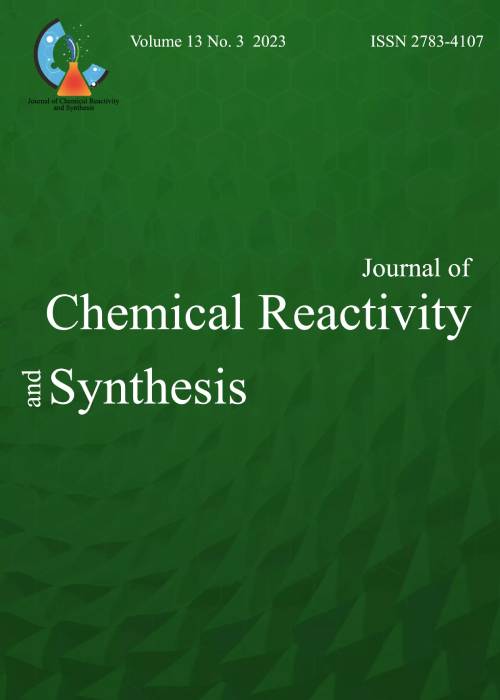فهرست مطالب

Journal of Chemical Reactivity and Synthesis
Volume:4 Issue: 1, Winter-Spring 2014
- تاریخ انتشار: 1393/03/11
- تعداد عناوین: 6
-
Pages 1-11In this research, some of the inorganic complexes of uranyl with N- donor ligandswere synthesized. Complexes were characteriezed by FT-IR and UV spectra, ¹HNMR,¹³CNMR and some physical properties. The uranyl unit (UO2) is composed of a center ofuranium atom with the charge (+6) and two oxygen atom by forming two U=O double bonds.The structure is linear (O=U=O, 180) and usually stable. So other ligands often coordinate tothe U atom in the plane perpendicularly to the O=U=O axis. The antitumor activity of some ofligand and their complexes against a panel of human tumor cell lines (HT29: Haman colonadenocarcinoma cell line T47D: human breast adenocarcinoma cell line) were determined byMTT(3-[4,5-dimethylthiazol-2-yl]-2,5-diphenyl-tetrazolium bromide) assay. These datasuggest that some of these compounds provide good models for the further design of potentantitumor compounds.Keywords: Inorganic, Uranyl complex-donor ligands, Schiff bases, Anticancer Activity
-
Pages 12-191,4-bis(triphenyl phosphonium)butane peroxodisulfate(BTPPBPDS) were synthesized by treating 1,4-bis(triphenyl phosphonium)butane dibromide and potassium peroxydisulfate in aqueous solution.This was used mild and efficient reagent for oxidation of alkyl benzenes to their corresponding carbonyl compounds in very good to high yields.Keywords: 4-bis(triphenyl phosphonium)butane - alkyl benzenes - carbonyl compounds
-
Pages 20-29New pyrimido [4, 5-e] [1, 3, 4]thia- diazin-7-yl] hydrazines were synthesized via the cyclocondensation of alkyl-2-phenylhydrazinecarbodithioates as a binucleophile with 5-bromo-2,4-dichloro-6-methylpyrimidine as a bielectrophile , and replacement of C-7 chloro atom by hydrazine in ethanol as the solvent . This method has advantages over methods currently described in the literature for the construction of such heterocyclic ring systems.Keywords: heterocyclization, 5-Bromo-2, 4-dichloro-6-methylpyrimidine, Pyrimido[4, 5-e][1, 3, 4]thiadiazine, Binucleophile, Bielectrophile
-
Pages 31-44In This applicable research, investigating absorption of process ofErythrosine dye on Copper oxide Nano particles Adsorbent was studied. First, prepared dyeconcentrations of 6, 8 and 12 mg L-1 and then effects of parameters such as concentrations ofinitial dye, time and pH on dye absorption efficiency were investigated.The dyeconcentrations in different samples were measured via spectrophotometer (505.6 nm for dyeErythrosine wavelength).The results of absorption studies showed that Erythrosine absorption or removal rateswould increase with decreasing the primary dye concentration, increasing reaction time , anddecreasing pH on the basis of the results, copper oxide Nano particles can the absorbErythrosine dye appropriately and efficiency of the process is higher in acidic pH for dyeErythrosine. The maximum dye removal of 93.68 % could be achieved at initial pH 2 usingadsorbent dosage of 0.233gr in 50 ml (12 mg L-1 dye concentration) and agitation rate of 180rpm. Effect of different parameters as kinetic parameters, were calculated pseudo-First andsecond-order kinetic, the Langmuir and Freundlich models Isotherm for absorb of this dye onadsorbent. this results showed that second-order kinetic adherence possessing regressioncoefficient of R2 ≥ 0.999, absorption or removal of Erythrosine on Copper oxide nanoparticles and different parameters for investigating of process rate of absorption in to be thisexperience. Equilibrium data fitted well with the Langmuir model for dye with adsorbent.Keywords: CuO nano particles, Erythrosine dye, absorption
-
Pages 45-54New 1,5-tetra alkyl methyl- phenyl-1H-pyrimido[4,5-e][1,3,4]thiadiazine-3,7-diamine were synthesized via the cyclocondensation of 2-(5-bromo-2-chloro-6-methylpyrimidin-4-yl)-2-methylhydrazine with phenylthioisothiocyanate and further replacement of chlorine atom on the seven number position of pyrimido[4, 5- e][1, 3, 4]thiadiazin by appropriate secondary amines in simple and efficient methods.Keywords: heterocyclization, 5- bromo- 2, 4- dichloro-6- methylpyrimidine, 2-(5-bromo-2-chloro-6-methylpyrimidin-4-yl)-2-methylhydrazine, phenylthioisothiocyanate
-
Pages 55-65Acenaphtho derivatives have been reported as antitumor agents. So, the reaction of acenaphthylene-1,2-dione with 3,4-diaminobenzenethiol, and then with the alkyl chloride derivatives for the synthesis of acenaphtho [1,2-b] quinoxalines are reviewed. Excellent yields of the products, short reaction times and simple work-up are attractive features of this suitable protocol.Keywords: Synthesis, Acenaphthene-1, 2-dione, pyrimidine, quinoxalines


